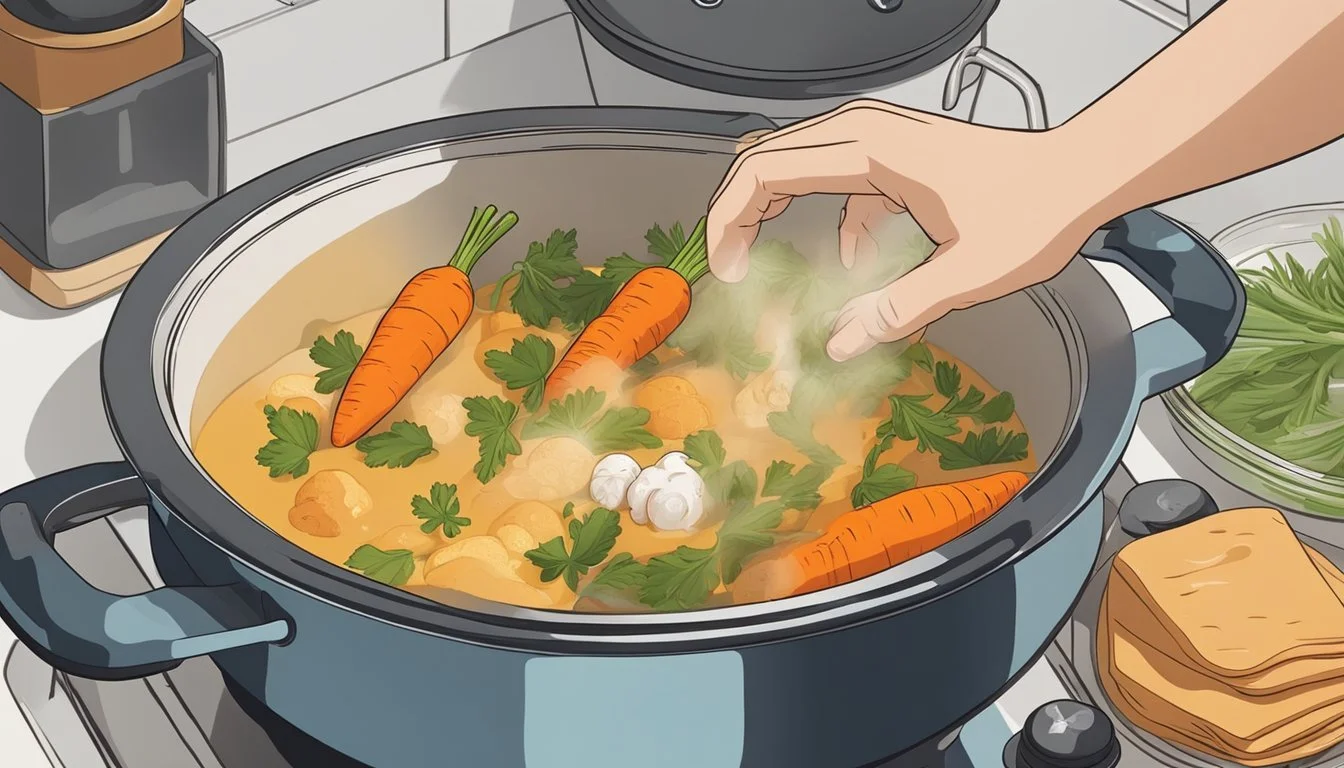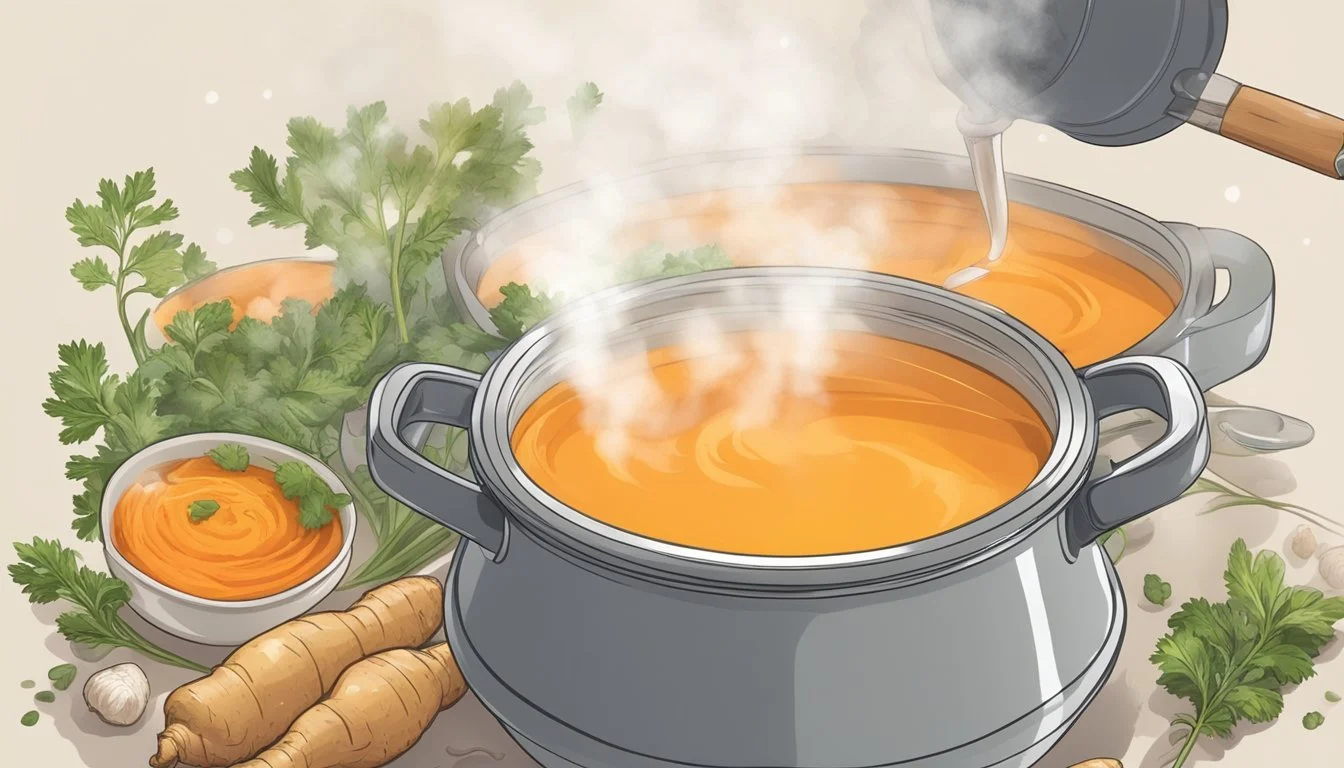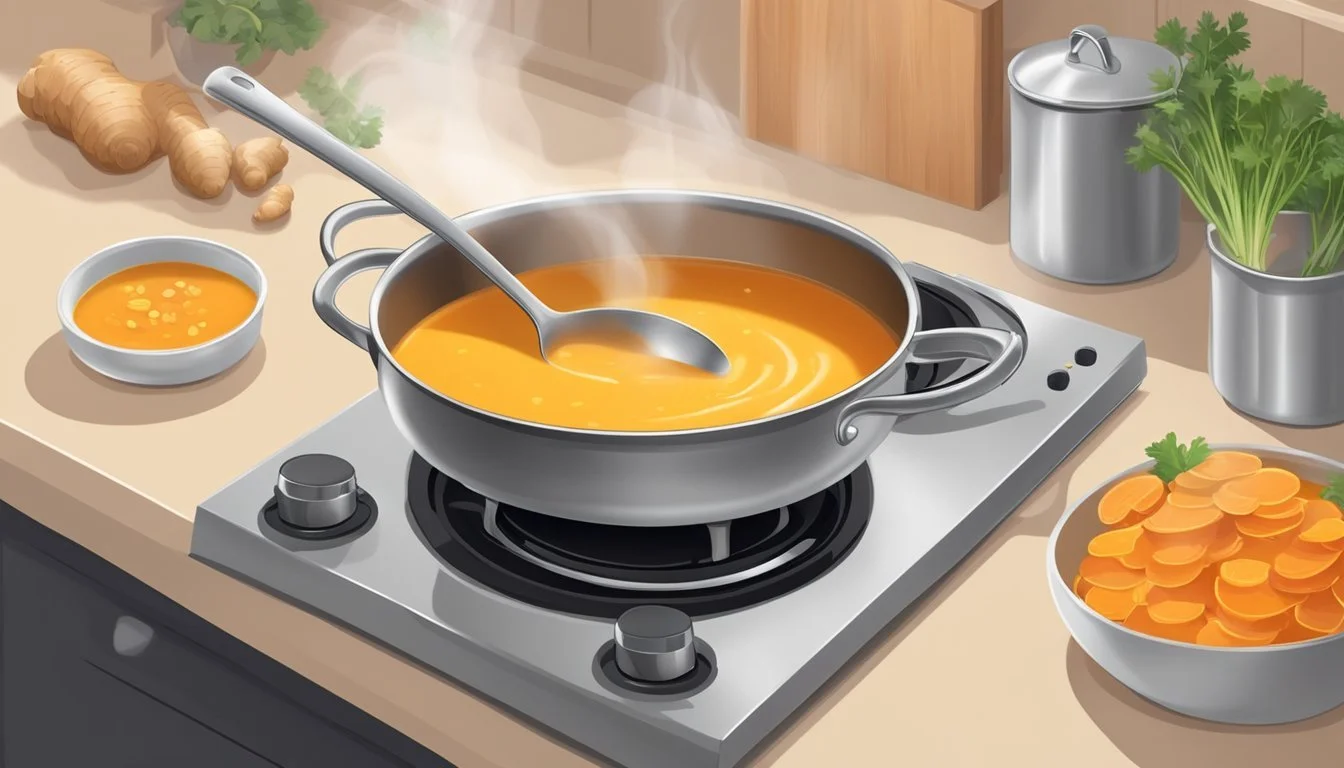Best Way to Reheat Ginger Carrot Soup
Ensuring a Silky Texture Every Time
Ginger carrot soup, with its rich blend of flavors and creamy texture, is a delicious comfort food. To maintain the soup's smooth consistency and vibrant taste, reheating it properly is essential. The right reheating technique ensures that the soup's creamy texture is preserved without the flavors becoming dull or the ingredients separating.
When it comes to reheating, gradual warmth is key. An even, gentle heat allows the flavors of ginger and carrot to meld harmoniously while preventing the soup from becoming too thin or unevenly heated. It's also vital that the soup is heated to just the right temperature to avoid any changes in its velvety consistency, which is one of the hallmark features of a well-prepared ginger carrot soup.
Using the proper tools, such as an immersion or stand blender, can help in restoring the soup's smooth texture if it has become thicker after storage. Blenders can reintegrate any separated components, returning the soup to the right consistency. Additionally, slow and careful reheating helps to unlock the aromatic qualities of ginger, highlighting the soup's comforting warmth that makes it so appealing.
Selecting Ingredients for the Perfect Blend
The foundation of a smooth and comforting ginger carrot soup starts with the selection of high-quality ingredients. They must complement each other to create a harmonious blend that caters to various dietary preferences such as vegan, vegetarian, paleo, and gluten-free lifestyles.
Choosing the Right Carrots
Carrots are the main ingredient, and their quality is paramount. Opt for organic carrots if possible, as they typically possess a richer flavor and natural sweetness. Large, firm carrots tend to have a concentrated taste and when peeled, reveal a tender flesh that purees well for a smooth soup texture.
The Role of Ginger
Fresh ginger brings heat and zest to the soup. Use fresh ginger root to ensure a vibrant flavor profile. The amount of ginger can be adjusted based on preference, but typically about a 2-inch piece, peeled and minced, suffices to imbue the soup with its characteristic warmth without overpowering the carrots' sweetness.
Incorporating Onions and Garlic
The soup's savory depth is enhanced with the inclusion of onions and garlic. A medium yellow onion should be peeled and finely chopped to provide a mellow, aromatic base. Garlic, preferably 2-3 cloves, adds complexity and should be peeled and minced. Both should be sautéed until translucent, using olive oil for a vegan option or butter for a richer taste, setting the stage for the flavors to meld seamlessly.
Smooth Soup Preparation Techniques
Preparing ginger carrot soup involves careful consideration of both cooking methods and texture-enhancing techniques. The goal is to achieve a rich and smooth consistency that remains comforting when reheated.
Cooking Methodology
When cooking a smooth soup such as ginger carrot soup, one begins by sautéing aromatics like onions, garlic, and ginger, which is essential for flavor development. For a rich, velvety texture, sweet potatoes or butternut squash can be added due to their high fiber content which contributes to the overall creaminess. These ingredients should be cooked until they’re soft, which, on the stovetop in a Dutch oven or large saucepan, typically takes 20-30 minutes. Alternatively, an Instant Pot can expedite the process, reducing cook time significantly.
Prep Time: 10-15 minutes
Cook Time: 20-30 minutes (Stovetop) / 10-15 minutes (Instant Pot)
Creating a Creamy Texture
Once the ginger carrot soup base is cooked, creating a creamy texture is the next step. Adding potatoes adds starch which naturally thickens the soup, while incorporating a modest amount of cream can introduce a luxurious mouthfeel without excessive saturated fat. Pureeing the soup with an immersion blender directly in the pot or transferring to a standard blender in batches achieves a homogenously smooth consistency.
Tools: Dutch oven or saucepan, blender/immersion blender
Ingredients: Potatoes, cream
Soup Thinning Solutions
Carrot ginger soup may thicken upon cooling or reheating. To restore a velvety texture, one may add a splash of vegetable stock, chicken broth, or water. One should add this gradually while reheating the soup over medium heat, stirring continuously to maintain a smooth texture. Using low-sodium options allows one to control the amount of minerals and sodium, ensuring not to overpower the soup's delicate flavors.
Reheating Liquids: Water, vegetable stock, chicken broth
Method: Stir continuously on medium heat
Flavor Enhancement
Proper seasoning and the incorporation of aromatic herbs and spices are essential when reheating ginger carrot soup to enhance its flavor. They ensure the soup maintains its comforting and complex taste profile.
Seasoning for Depth
When adding seasoning to ginger carrot soup during the reheating process, one must consider the balance of flavors. The use of kosher salt is preferred for its pure taste and ability to dissolve easily, which provides a more even distribution of sodium throughout the soup. One should start with a pinch, taste, and adjust as needed. Alongside kosher salt, a touch of black pepper can be added to introduce a slight sharpness that complements the sweetness of the carrots and the warmth of the ginger.
Herbal and Spicy Additions
For additional complexity, introducing herbs and spices can significantly elevate the soup. A modest amount of turmeric can be sprinkled in, not only for its earthy flavor but also for its vibrant color and health benefits. Moreover, considering the soup's existing flavor profile, incorporating freshly grated ginger can accentuate the soup's spicy undertones without overpowering it. When integrating herbs and spices, they should be added sparingly and tasted frequently during reheating to ensure that the enhancement is proportional and harmonious.
Effective Reheating Methods
To preserve the smooth texture and rich flavor of ginger carrot soup, careful reheating is essential. Whether using a stovetop, microwave, or oven, each method has specific steps to ensure the soup remains creamy and ready to serve.
Stovetop Reheating
Reheating ginger carrot soup on the stovetop is best done in a saucepan over low heat. It is crucial to stir the soup frequently to prevent sticking and to ensure even heating without boiling, which can alter the soup's texture.
Steps:
Pour the soup into a saucepan.
Heat on low, stirring occasionally.
Serve once heated through, paired with crusty bread if desired.
Microwave Heating
For a quicker option, microwave reheating works well, especially for single servings. The key is to cover the soup to retain moisture and to stir midway to redistribute heat.
Steps:
Transfer soup to a microwave-safe bowl.
Cover with a microwave-safe lid, leaving a vent for steam.
Heat in intervals, stirring each time to maintain a smooth consistency.
Utilizing the Oven
Reheating in the oven is less common for pureed soups (What wine goes well with soups?) but can work for ginger carrot soup, especially when aiming to serve a large quantity at once.
Steps:
Preheat oven to 350°F (175°C).
Place the soup in an oven-safe dish.
Cover with aluminum foil and heat until warm, ensuring it doesn't dry out or burn.
By following these methods, one can effectively reheat ginger carrot soup, keeping its comforting qualities intact.
Storing and Preservation Tips
Proper storage of ginger carrot soup ensures it maintains its texture and flavor. Here are specific methods to refrigerate and freeze this comforting dish.
Refrigerating Soup Properly
For refrigeration, one should cool the ginger carrot soup to room temperature before storing. Do not leave the soup out for longer than 2 hours to avoid bacterial growth. An ice bath can hasten the cooling process. Once cool, divide the soup into portions and store in airtight containers; this prevents contamination and odor absorption. Ginger carrot soup with cream or coconut milk should be stored in the fridge and consumed within 2-3 days to ensure freshness and prevent the dairy or coconut milk from spoiling.
Cooling Time: No more than 2 hours at room temperature
Storage Method: Airtight containers
Shelf Life: 2-3 days for cream or coconut milk-based soups
Freezing for Longevity
When freezing ginger carrot soup, ensure all ingredients are freeze-friendly. Soups with cream or canned coconut milk can separate when frozen, so it's better to freeze the soup base without these additions and add them when reheating. Use freezer-safe containers or bags, leaving some space at the top as the soup will expand when frozen. Clearly label each container with the date and contents. The soup can be stored in the freezer for up to 2-6 months. To utilize frozen soup, thaw overnight in the refrigerator or use the defrost setting on a microwave before reheating.
Containers: Freezer-safe, with space for expansion
Labeling: Date and contents
Shelf Life: Up to 2-6 months
Soup Pairings and Serving Suggestions
Enjoying carrot ginger soup to its fullest often involves combining it with the right accompaniments that complement its flavors and textures. Selecting the proper pairings can transition this dish from a simple appetizer to a complete and satisfying meal.
Accompaniments for Carrot Ginger Soup
When serving carrot ginger soup, it is beneficial to consider items that contrast with its smooth texture and sweet, spicy flavor profile. Here are recommended pairings:
Bread: A slice of crusty bread makes an excellent companion to carrot ginger soup. It can be used to soak up the flavorful broth and adds a satisfying crunchy texture to the meal.
Grilled Cheese: Serving the soup with a grilled cheese sandwich offers a delightful pairing, the crispy, buttery bread and melted cheese complementing the soup's creamy consistency.
Garnishes: To elevate the presentation and flavor, one can garnish the soup with a dollop of cream, a drizzle of olive oil, or fresh herbs, providing rich smoothness or a vibrant, herby contrast.
Meal Prep: For those looking to incorporate carrot ginger soup into their meal prep routine, it stores well when refrigerated or frozen, pairing easily with pantry staples for a quick and nourishing meal.
Nutritional Information and Considerations
Ginger carrot soup is not only a comforting meal but also a nutritious choice that offers an array of health benefits. Each bowl typically contains a substantial amount of vitamin A, vital for healthy vision and immune function, and vitamin C, essential for skin health and immune defense. The base ingredients, carrots and ginger, are low in calories and rich in fiber, aiding in digestion and satiety.
Nutrients per serving (approximations):
Calories: 100-150
Saturated Fat: <1g
Cholesterol: 0mg
Sodium: 300-400mg
Potassium: 500-700mg
Carbohydrates: 15-25g
Dietary Fiber: 4-6g
Sugars: 5-10g
Vitamin A: 100-150% RDI
Vitamin C: 10-20% RDI
Calcium: 4-6% RDI
Iron: 4-6% RDI
The soup’s potassium content helps maintain electrolyte balance and proper heart function. Low in saturated fat and containing no cholesterol, ginger carrot soup is heart-friendly. It usually has modest amounts of sodium, but this can vary based on recipe modifications.
The soup's golden hue comes from beta-carotene, an antioxidant found in carrots that the body converts to vitamin A. Antioxidants help in fighting off oxidative stress, reducing the risk of chronic diseases. Adding healthy fats, such as polyunsaturated and monounsaturated fats, can be beneficial; these can be sourced from oil used for sautéing aromatics or from garnishes like avocado or seeds.
For those monitoring sugar intake, it's worth noting that carrots contain natural sugars, which can accumulate depending on the quantity used. However, these natural sugars are accompanied by fiber, which moderates blood sugar spikes.
In conclusion, ginger carrot soup delivers key nutrients and antioxidants with the bonus of being easy to digest, making it an ideal dish for those seeking a nourishing and comforting meal.








